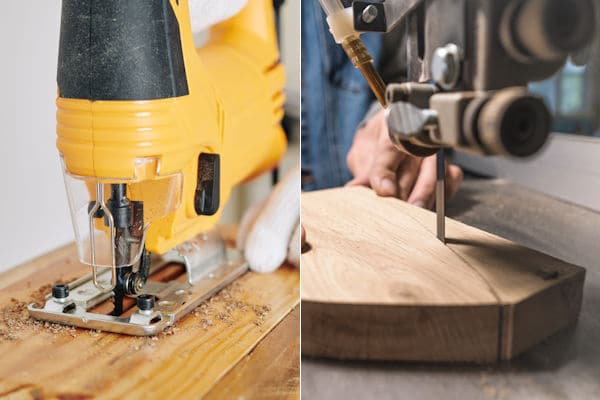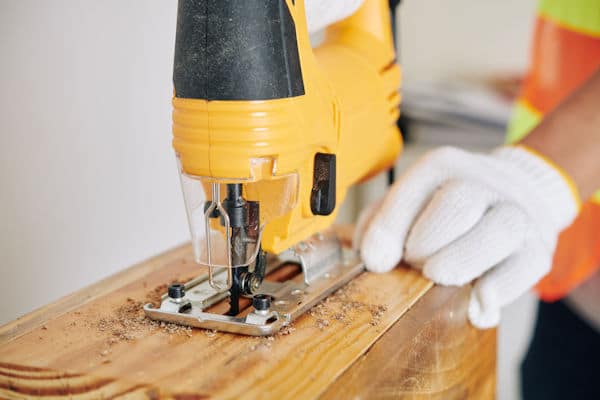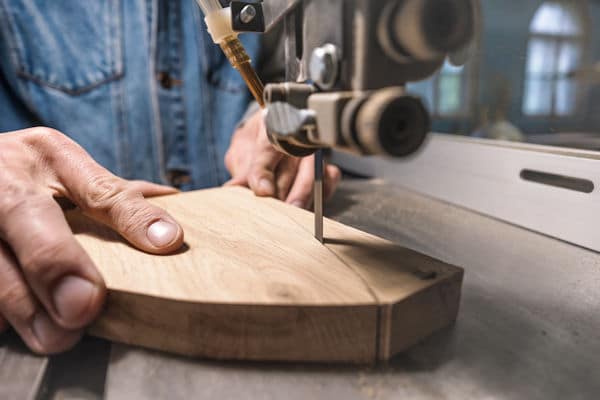 The saw industry can be complex and confusing, especially to beginners. Finding a saw that best suits your project description can be draining. Every saw available in the saw world has different functionality and application. Thus, there is a need to identify the features and use of a saw before purchasing.
The saw industry can be complex and confusing, especially to beginners. Finding a saw that best suits your project description can be draining. Every saw available in the saw world has different functionality and application. Thus, there is a need to identify the features and use of a saw before purchasing.
Jigsaw and band saw are the most popular saws among DIYers, woodworkers and carpenters, and woodcarvers. Making a decision on which to pick can be a hassle given their functionalities. Having the knowledge and insights of both the jigsaw and band saws enables a user to determine which is best to use for a particular task.
What is a Jig Saw?
 A jigsaw is a lightweight handheld and portable power tool. It has a reciprocating saw blade attached to the motor. It can be corded or cordless. The cordless jigsaws are very convenient and easy to use without chances of tangles around the workshop. The tool is used by DIYers and professionals to make cuts on different materials such as wood and metal.
A jigsaw is a lightweight handheld and portable power tool. It has a reciprocating saw blade attached to the motor. It can be corded or cordless. The cordless jigsaws are very convenient and easy to use without chances of tangles around the workshop. The tool is used by DIYers and professionals to make cuts on different materials such as wood and metal.
Jigsaws are easy to control when making curved cuts due to the handheld feature. They can easily make complicated curved cuts, straight cuts and rough cuts, slow and fast cuts as needed. With a narrow blade, the jigsaw can create a small radius curve. This is rare with any other power saw.
What is a Band Saw?
 The band saw is a stationary power tool that features a circular blade that revolves quickly in orbit. It has a belt-like blade that is attached to the discs of the saw. The motor of the saw spins the blade making it possible to have the desired cuts.
The band saw is a stationary power tool that features a circular blade that revolves quickly in orbit. It has a belt-like blade that is attached to the discs of the saw. The motor of the saw spins the blade making it possible to have the desired cuts.
Bands are either horizontal or vertical. The method used to cut a given material depends on the build and model of the band saw. For the horizontal band saws, the piece to be cut is fed into the blade path. The vertical band saw lowers the blade on the material by hydraulics while cutting.
Band saws are commonly used by professionals and DIYers for re-sawing wood and making precision cuts and designs. The position of the band saw blades enables the making of curved cuts, designs, and straight cuts on wood.
Similarities between Jigsaw and Band Saw
Other than straightforward and ease of use, the jigsaw and band saw have notable similarities:
- Both saws have thin blades with teeth for making straight and curved cuts
- Both are power saws that move the blade so that the teeth can make the desired cuts
- Both saw are capable of providing precision and clean slices
- Both of them are excellent for wood cutting
- The blades in both saws use upward and downward motion when cutting
Differences between Jigsaw and Band Saw
Here are the primary differences between the two:
- Jigsaws are handheld power tools that are light in weight. They also come in corded and cordless versions. Band saws are stationary power tools that are bulky in size. They are used on a table or a secure stationary location. Even with portable band saws, they are still heavier than jigsaws.
- Jigsaws are used to make precise, tiny cuts and complex curves. They are also useful when dealing with rough cuts. Band saws are used to make broad cuts and re-sawing wood. They are also used for precise large-scale cutting such as chopping large lumber chunks.
- Jigsaws have thin and shorter blades ranging between 4-inches and 6-inches. The jigsaw blades also have fewer teeth. Band saws have long blades wrapped around the wheel to avoid tangling. The band saw blades are also thicker and wider and have more teeth which improve the accuracy.
- Jigsaws are capable of making more curves and cuts. They produce more accurate curves. Band saws are more precise and are the best for making more accurate straight cuts.
- A jigsaw is only capable of cutting wood pieces that are an inch shorter than the length of the blade. Mostly, the wood thickness is around 3-inches. A band saw is capable of cutting more dense wood pieces and a stack of wood pieces at a go. Some band saws have a 12-inch sawing capacity, thus used in large workshops.
- A jigsaw’s average cutting speed is about 1500 square per minute. A band saw average cutting speed is around 1000 feet per minute making it faster than a jigsaw.
- Jigsaws can cut any given material given the right blade with ease. They can also cut through corners and tight spaces thus majorly used by electricians and plumbers. Band saws are limited to cutting wood and plastic except for the metal band saws that cut metal. They cannot cut through corners and tight spaces due to their size.
- A jigsaw is easy to clean and maintain as it requires nothing extra when it comes to cleaning agents. Band saws have internal parts which require an extensive cleaning and maintenance routine. Parts such as wheels and motor need to be oiled and cleaned regularly.
Practical application of Jigsaw and Band saw
Jigsaws are portable, versatile and can make different types of cuts even without cutting through the wood. They can be best used for:
- Working on site
- Cutting pieces that cannot be moved
- Tracing narrow curves or board
- Cutting through dry walls, plastics, wood, metals, gypsum board among other materials
- Making bevel cuts and crosscuts
- Making holes inside wood materials
Band Saws have the advantage of having a table, fence, and long-cutting blade. With these features, it is best used for:
- Re-sawing wood boards
- Remodeling woodblock
- Making precise cuts
- Cutting accurate curved lines and circles
- Making repeated cuts
Which one is better?
The two power tools have great features and offer different options for every user. Choosing either of the tools should depend on your professional or hobby, tasks in question, workspace, and storage facilities. The skills, expertise, and material to be used plays a major role in choosing whether to use a jigsaw or a band saw.
For simple woodworking projects, beginners, and making straight cuts, the jigsaw is the ideal tool. For woodcutting, re-sawing, bigger cuttings, and stationary power tools, the band saw is the best suited. The tool is great for woodworkers and professionals who have bigger projects that require heavy tools.
Having both tools in your workshop can come in handy. For safety, ensure that you use each tool for its designated purpose to avoid disasters and injuries in the workshop.